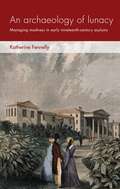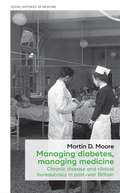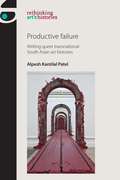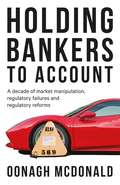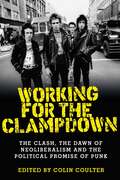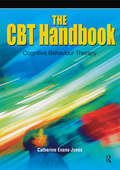- Table View
- List View
Irish cinema in the twenty-first century
by Ruth BartonAn accessible, comprehensive overview of contemporary Irish cinema, this book is intended for use as a third-level textbook and is designed to appeal to academics in the areas of film studies and Irish studies. Responding to changes in the Irish production environment, it includes chapters on new Irish genres such as creative documentary, animation and horror. It discusses shifting representations of the countryside and the city, always with a strong concern for gender representations, and looks at how Irish historical events, from the Civil War to the Troubles, and the treatment of the traumatic narrative of clerical sexual abuse have been portrayed in recent films. It covers works by established auteurs such as Neil Jordan and Jim Sheridan, as well as new arrivals, including the Academy Award-winning Lenny Abrahamson.
Austerity baby
by Janet WolffAusterity Baby might best be described as an ‘oblique memoir’. Janet Wolff’s fascinating volume is a family history – but one that is digressive and consistently surprising. The central underlying and repeated themes of the book are exile and displacement; lives (and deaths) during the Third Reich; mother-daughter and sibling relationships; the generational transmission of trauma and experience; transatlantic reflections; and the struggle for creative expression. Stories mobilised, and people encountered, in the course of the narrative include: the internment of aliens in Britain during the Second World War; cultural life in Rochester, New York, in the 1920s; the social and personal meanings of colour(s); the industrialist and philanthropist, Henry Simon of Manchester, including his relationship with the Norwegian explorer, Fridtjof Nansen; the liberal British campaigner and MP of the 1940s, Eleanor Rathbone; reflections on the lives and images of spinsters. The text is supplemented and interrupted throughout by images (photographs, paintings, facsimile documents), some of which serve to illustrate the story, others engaging indirectly with the written word.An electronic edition of this book is freely available under a Creative Commons (CC BY-NC-ND) licence.
An archaeology of lunacy: Managing madness in early nineteenth-century asylums (Social Archaeology and Material Worlds)
by Katherine FennellyAn archaeology of lunacy is a materially focused exploration of the first wave of public asylum building in Britain and Ireland, which took place during the late-Georgian and early Victorian period. Examining architecture and material culture, the book proposes that the familiar asylum archetype, usually attributed to the Victorians, was in fact developed much earlier. It looks at the planning and construction of the first public asylums and assesses the extent to which popular ideas about reformed management practices for the insane were applied at ground level. Crucially, it moves beyond doctors and reformers, repopulating the asylum with the myriad characters that made up its everyday existence: keepers, clerks and patients. Contributing to archaeological scholarship on institutions of confinement, the book is aimed at academics, students and general readers interested in the material environment of the historic lunatic asylum.
Research in Accounting Regulation (Research in Accounting Regulation #Volume 18)
by Gary J. Previts Thomas R. Robinson Nandini Chandar Julia E.S. Grant Larry M. ParkerThe scope of service provided by professional accountants is influenced by legislation and case law as well as the dictates of a variety of government and private sector agencies; including State Boards of Accountancy, Academic Accreditation Bodies, the United States Securities and Exchange Commission, the Public Accounting Oversight Board, independent standard setting bodies such as the Federal Accounting Standards Advisory Board [US], the Financial Accounting Standards Board [US] and the International Accounting Standards Board. These entities and self-regulatory organizations such as U.S. State Societies of CPAs and the American Institute of Certified Public Accountants and equivalent and emerging national bodies that exist in most developed and developing countries, are among the emerging entities which attempt to coordinate the activities of professional accountants among sovereign nations. It is important for academics, students, practitioners, regulators and researchers to consider and study the role and relationship of such bodies with the practice and content of our discipline. Research in Accounting Regulation seeks high quality manuscripts which address accounting regulatory policy, broadly defined, including: 1. self regulatory activities 2. case law and litigation 3. legislation and government regulation 4. the economics of regulation of markets, and disclosure, including modeling 5. matters involving the structure of education, licensing, and accreditation The editors encourage submission of original empirical, behavioral or applied research manuscripts which consider strategic and policy implications for regulation, regulatory models and markets. It is intended for individual researchers, practitioners, regulators and students of accountancy who desire to increase their understanding of the regulation of accountancy.
The economics of disability: Insights from Irish research (Irish Society)
by John Cullinan, Seán Lyons and Brian NolanThis book brings together research relating to the economics of disability in Ireland. It addresses a range of issues of relevance to the economic circumstances of people with disabilities, considering topics such as social inclusion, poverty, the labour market, living standards and public policy. It also considers issues of specific relevance to children, working-age adults and older people with disabilities, providing important evidence that can help improve disability policies, services and supports. Each chapter presents a clear and relatively non-technical treatment of the specific topic under consideration, making it accessible to a greater number of interested readers. In doing so, it provides an important addition to our knowledge and understanding of the economics of disability and will serve as a useful and up-to-date resource for a range of interested parties both in Ireland and internationally.
Encountering extremism: Theoretical issues and local challenges
by Alice Martini, Kieran Ford and Richard JacksonEncountering Extremism offers readers the opportunity to interrogate extremism through a plethora of theoretical perspectives and explore counter-extremism as it has materialised in plural local contexts. Offering a unique, in-depth critical interrogation, this volume seeks to understand and expose the implications of a fundamental problematic: how should scholars and strategists alike understand the contemporary shift from counter-terrorism to counter-extremism?Representing the first collection of scholarly works encountering this present problem of extremism and counter-extremism, this edited volume addresses the need for a critical examination of both the theoretical and the practical implications of this recent conceptual shift. For this very reason, this book brings together a diverse range of scholars, experts and practitioners to present valuable multidisciplinary analyses of the theory and practicalities of countering extremism. It is in this combination of both theoretical investigation and empirical analyses of local realities that the volume finds its added value, offering a unique contribution to a vital field of academic study.
The Levellers: Radical political thought in the English Revolution (Politics, Culture and Society in Early Modern Britain)
by Rachel FoxleyThe Leveller movement of the 1640s campaigned for religious toleration and a radical remaking of politics in post-civil war England. This book, the first full-length study of the Levellers for fifty years, offers a fresh analysis of the originality and character of Leveller thought. Challenging received ideas about the Levellers as social contract theorists and Leveller thought as a mere radicalisation of parliamentarian thought, Foxley shows that the Levellers’ originality lay in their subtle and unexpected combination of different strands within parliamentarianism. The book takes full account of recent scholarship, and contributes to historical debates on the development of radical and republican politics in the civil war period, the nature of tolerationist thought, the significance of the Leveller movement and the extent of the Levellers’ influence in the ranks of the New Model Army.
French children under the Allied bombs, 1940–45: An oral history (Cultural History of Modern War)
by Lindsey DoddChildren under the Allied bombs in France provides a unique perspective on the Allied bombing of France during the Second World War which killed around 57,000 French civilians. Using oral history as well as archival research, it provides an insight into children's wartime lives in which bombing often featured prominently, even though it has slipped out of French collective memory. How prepared were the French for this aerial onslaught? What was it like to be bombed? And how did people understand why their 'friends' across the Channel were attacking them? Divided into three parts dealing with expectations, experiences and explanations of bombing, this book considers the child's view of wartime violence, analysing resilience, understanding and trauma. It contributes significantly to scholarship on civilian life in Occupied France, and will appeal to students, academics and general readers interested in the history of Vichy France, oral history and the experiences of children in war.
Managing diabetes, managing medicine: Chronic disease and clinical bureaucracy in post-war Britain (Social Histories of Medicine #15)
by Martin D. MooreThrough its study of diabetes care in twentieth-century Britain, Managing diabetes, managing medicine offers the first historical monograph to explore how the decision-making and labour of medical professionals became subject to bureaucratic regulation and managerial oversight. Where much existing literature has cast health care management as either a political imposition or an assertion of medical control, this work positions managerial medicine as a co-constructed venture. Although driven by different motives, doctors, nurses, professional bodies, government agencies and international organisations were all integral to the creation of managerial systems, working within a context of considerable professional, political, technological, economic and cultural change.An electronic edition of this book is freely available under a Creative Commons (CC BY) licence.
Decolonising the Hajj: The pilgrimage from Nigeria to Mecca under empire and independence (Studies in Imperialism #208)
by Matthew HeatonMuslims from the region that is now Nigeria have been undertaking the Hajj for hundreds of years. But the process of completing the pilgrimage changed dramatically in the twentieth century as state governments became heavily involved in its organization and management. Under British colonial rule, a minimalist approach to pilgrimage control facilitated the journeys of many thousands of mostly overland pilgrims. Decolonization produced new political contexts, with nationalist politicians taking a more proactive approach to pilgrimage management for both domestic and international reasons. The Hajj, which had previously been a life-altering journey undertaken slowly and incrementally over years, became a shorter, safer, trip characterized by round trip plane rides. In examining the transformation of the Nigerian Hajj, this book demonstrates how the Hajj became ever more intertwined with Nigerian politics and governance as the country moved from empire to independence.
Productive failure: Writing queer transnational South Asian art histories (Rethinking Art's Histories)
by Alpesh Kantilal PatelThis title sets out to write new transnational South Asian art histories - to make visible histories of artworks that remain marginalised within the discipline of art history. However, this is done through a deliberate 'productive failure' - specifically, by not upholding the strictly genealogical approach that is regularly assumed for South Asian art histories. For instance, one chapter explores the abstract work of Cy Twombly and Natvar Bhavsar. The author examines 'whiteness', the invisible ground upon which racialized art histories often pivot, as a fraught yet productive site for writing art history. This book also provides original commentary on how queer theory can deconstruct and provide new approaches for writing art history. Overall, this title provides methods for generating art history that acknowledge the complex web of factors within which art history is produced and the different forms of knowledge-production we might count as art history.
Basic Physics Of Radiotracers: Volume II (CRC Press Revivals)
The opportunity to present the physics of radioactive processes in some detail apart from topics such as instrumentation which conventionally compete with it for spacer is most welcome. The material is intended to give a fairly complete introduction to radiation physics to those who which to have more than a descriptive understanding of the subject. Although it is possible to work one’s way through much of the subject matter without having any previous physics background, some prior acquaintance with modern physics is desirable. A familiarity with calculus and differential equations is also assumed. Volume I begins with a brief description of classical physics, it’s extension to special relativity and quantum mechanics, and an introduction to basic atomic and nuclear concepts. A thorough discussion of atomic structure follows with emphasis on the theory of the multielectron atom, characteristic X-rays, and the Auger effect. Volume II treats the subjects of nuclear structure, nuclear decay processes, the interaction of radiation with matter, and the mathematics of radioactive decay.
Odd men out: Male homosexuality in Britain from Wolfenden to Gay Liberation: Revised and updated edition (G - Reference,information And Interdisciplinary Subjects Ser.)
by John-Pierre JoyceFrom government ministers and spies to activists, drag queens and celebrities, Odd men out charts the tumultuous history of gay men in 1950s and 60s Britain. It takes us from the earliest tentative steps towards decriminalisation to the liberation movement of the early 1970s. Along the way, it catalogues shocking repression, including laws against homosexual activity and the use of brutal medical ‘treatments’. Odd men out draws on medical data and opinion polls, broadcast recordings, theatrical productions, and extensive interviews with key players, as well as an in-depth analysis of the Wolfenden Report and the circumstances surrounding its creation. It brings to life pivotal moments in gay mens’ cultural representation, ranging across the West End and emerging writers like Joe Orton, the British film industry, the BBC, national newspapers, fashion catalogues and music magazines. Celebrating the joy of gay lives as well as the hardships, Odd men out preserves the voices of a disappearing generation who revolutionised what it meant to be a gay man in twentieth-century Britain.
Histories of nursing practice (Nursing History and Humanities)
by Gerard M. Fealy, Christine E. Hallett, and Susanne Malchau DietzHow did skilled nursing practice develop to become an essential part of the modern health system? This book provides some important answers to this question. It traces the history and development of nursing practice in Europe and North America, exploring two broad categories of nursing work: the ‘hands-on’ clinical work of nurses in hospitals and the work of nurses in public health, which involved health screening, health education and public health crisis management. The book contains rich case studies of nursing practice across diverse settings in the nineteenth and twentieth centuries. As well as examining ‘what nurses did’, it explores the significance and meaning of nursing work, for nurses themselves, their patients and their communities, and examines developments in practice against a backdrop of social, cultural, political and economic drivers and constraints.This book will be of interest to academics and clinical nurses alike. It is also an ideal textbook for undergraduate nursing programmes, providing students with rich accounts of the history of their own disciplinary practice.
Colouring the Caribbean: Race and the art of Agostino Brunias (Rethinking Art's Histories)
by Mia L. BagnerisColouring the Caribbean offers the first comprehensive study of Agostino Brunias’s intriguing pictures of colonial West Indians of colour – so called ‘Red’ and ‘Black’ Caribs, dark-skinned Africans and Afro-Creoles, and people of mixed race – made for colonial officials and plantocratic elites during the late-eighteenth century. Although Brunias’s paintings have often been understood as straightforward documents of visual ethnography that functioned as field guides for reading race, this book investigates how the images both reflected and refracted ideas about race commonly held by eighteenth-century Britons, helping to construct racial categories while simultaneously exposing their constructedness and underscoring their contradictions. The book offers provocative new insights about Brunias’s work gleaned from a broad survey of his paintings, many of which are reproduced here for the first time.
Holding bankers to account: A decade of market manipulation, regulatory failures and regulatory reforms
by Oonagh McDonaldThis book provides a compelling account of the rigging of benchmarks during and after the financial crisis of 2007–08. Written in clear language accessible to the non-specialist, it provides the historical context necessary for understanding the benchmarks – LIBOR, FOREX and the Gold and Silver Fixes – and shows how and why they have to be reformed in the face of rapid technological changes in markets. Though banks have been fined and a few traders have been jailed, justice will not be done until senior bankers are made responsible for their actions. Provocative and rigorously argued, this book makes concrete recommendations for improving the security of the financial services industry and holding bankers to account.
War and welfare: British prisoner of war families, 1939–45
by Barbara HatelyDuring the Second World War, some 250,000 British servicemen were taken captive by either the Axis powers or the Japanese. As a result of this, their wives and families became completely dependent on the military and civil authorities. This book examines the experiences of the millions of service dependents created by total war. The book then focuses on the most disadvantaged elements of this group - the wives, children and dependents of men taken prisoner- and the changes brought about by the exigencies of total war. Further chapters reflect on how these families organised to lobby government and the strategies they adopted to circumvent apparent bureaucratic ineptitude and misinformation.This book is essential reading for both academic and general readers interested in the British Home Front during the Second World War.
Borderland: Identity and belonging at the edge of England
by Phil HubbardOver recent years, the issues of Brexit, COVID and the ‘migrant crisis’ put Kent in the headlines like never before. Images of asylum seekers on Kent beaches, lorries queued on motorways and the crumbling white cliffs of Dover all spoke to national anxieties, and were used to support ideas that severing ties with the EU was the best – or worst – thing the UK has ever done. In this coastal driftwork, Phil Hubbard – an exiled man of Kent – considers the past, present and future of this corner of England, alighting on a number of key sites which symbolise the changing relationship between the UK and its continental neighbours. Moving from the geopolitics of the Channel Tunnel to the cultivation of oysters at Whitstable, from Derek Jarman’s feted cottage at Dungeness to the art-fuelled gentrification of Margate, Borderland bridges geography, history, and archaeology, to pose important questions about the way that national identities emerge from contested local landscapes.
News and rumour in Jacobean England: Information, court politics and diplomacy, 1618–25 (Politics, Culture and Society in Early Modern Britain)
by David CoastThis study examines how political news was concealed, manipulated and distorted during the tumultuous later years of James I’s reign. It investigates how the flow of information was managed and suppressed at the centre, as well as how James I attempted to mislead a variety of audiences about his policies and intentions. It also examines the reception and unintended consequences of his behaviour, and explores the political significance of the mis- and dis-information that circulated in court and country. It thereby contributes to a wider range of historical debates that reach across the politics and political culture of the reign and beyond, advancing new arguments about censorship, counsel and the formation of policy; propaganda and royal image-making; political rumours and the relationship between elite and popular politics, as well as shedding new light on the nature and success of James I’s style of rule.
Irish Catholic identities
by Oliver P. RaffertyWhat does it mean to be Irish? Are the predicates Catholic and Irish so inextricably linked that it is impossible to have one and not the other? Does the process of secularisation in modern times mean that Catholicism is no longer a touchstone of what it means to be Irish? Indeed was such a paradigm ever true? These are among the fundamental issues addressed in this work, which examines whether distinct identity formation can be traced over time. The book delineates the course of historical developments which complicated the process of identity formation in the Irish context, when by turns Irish Catholics saw themselves as battling against English hegemony or the Protestant Reformation. Without doubt the Reformation era cast a long shadow over how Irish Catholics would see themselves. But the process of identity formation was of much longer duration. Newly available in paperback, this work traces the elements which have shaped how the Catholic Irish identified themselves, and explores the political, religious and cultural dimensions of the complex picture which is Irish Catholic identity. The essays represent a systematic attempt to explore the fluidity of the components that make up Catholic identity in Ireland.
Castles and colonists: An archaeology of Elizabethan Ireland (The Manchester Spenser)
by Eric KlingelhoferCastles and colonists is the first book to examine life in the leading province of Elizabeth I's nascent empire. Klinglehofer shows how an Ireland of colonising English farmers and displaced Irish 'savages' are ruled by an imported Protestant elite from their fortified manors and medieval castles.Richly illustrated, it displays how a generation of English 'adventurers' including such influential intellectual and political figures as Spenser and Ralegh, tried to create a new kind of England, one that gave full opportunity to their Renaissance tastes and ambitions.Based on decades of research, Castles and colonisers details how archaelogy had revealed the traces of a short-lived, but significant culture which has been, until now, eclipsed in ideological conflicts between Tudor queens, Hapsburg hegemony and native Irish traditions,
Greeks and Barbarians
by Thomas HarrisonGreeks and Barbarians examines ancient Greek conceptions of the "other." The attitudes of Greeks to foreigners and there religions, and cultures, and politics reveals as much about the Greeks as it does the world they inhabited. Despite occasional interest in particular aspects of foreign customs, the Greeks were largely hostile and dismissive viewing foreigners as at best inferior, but more often as candidates for conquest and enslavement.
British rural landscapes on film
by Paul NewlandBritish rural landscapes on film offers insights into how rural areas in Britain have been represented on film, from the silent era, through both world wars, and on into the twenty-first century. It is the first book to exclusively deal with representations of the British countryside on film. The contributors demonstrate that the countryside has provided Britain (and its constituent nations and regions) with a dense range of spaces in which cultural identities have been (and continue to be) worked through. British rural landscapes on film demonstrates that British cinema provides numerous examples of how national identity and the identity of the countryside have been partly constructed through filmic representation, and how British rural films can allow us to further understand the relationship between the cultural identities of specific areas of Britain and the landscapes they inhabit.
Working for the clampdown: The Clash, the dawn of neoliberalism and the political promise of punk (Current Practices in Ophthalmology)
by Colin CoulterThis volume brings together a range of writers from different academic disciplines and different locations to provide an engaging and accessible critical exploration of one of the most revered and reviled bands in the history of popular music. The essays collated here locate The Clash in their own explosive cultural moment of punk's year zero and examine how the group speaks from beyond the grave to the uncanny parallels of other moments of social and political crisis. In addition, the collection considers the impact of the band in a range of different geopolitical contexts, with various contributors exploring what the band meant in settings as diverse as Italy, England, Northern Ireland, Australia and the United States. The diverse essays gathered in Working for the clampdown cast a critical light on both the cultural legacy and contemporary resonance of one of the most influential bands ever to have graced a stage.
The CBT Handbook: Cognitive Behavioural Therapy
by Catherine Evans-JonesThis is a comprehensive resource of photocopiable worksheets to aid therapeutic intervention. Cognitive behavioural therapy (CBT) aims to help people overcome their emotional difficulties through helping them identify and change their thoughts and behaviour. CBT has been evaluated for a wide range of presenting problems and evidence of its efficacy found for depression, panic, agoraphobia, generalised anxiety disorder (GAD), specific phobia, social phobia, obsessive-compulsive disorder (OCD) and post-traumatic stress disorder (PTSD). This eminently practical book provides more than 80 A4 photocopiable worksheets for cognitive behavioural therapists to use with clients. As well as covering the fundamental techniques of CBT, it supplies worksheets specific to presenting problems, such as OCD, panic and worry. Worksheets are essential tools in CBT. They record events and patterns, provide new information, and suggest new ways of thinking and acting. When and how to use a worksheet is determined by a number of factors: the formulation, the stage in therapy, the current focus of treatment, the reading and writing ability of the client and the wishes of the client. The use of worksheets in CBT is an ongoing learning process for both therapists and clients. This is a fantastic resource for all clinicians working within the cognitive behavioural model.


